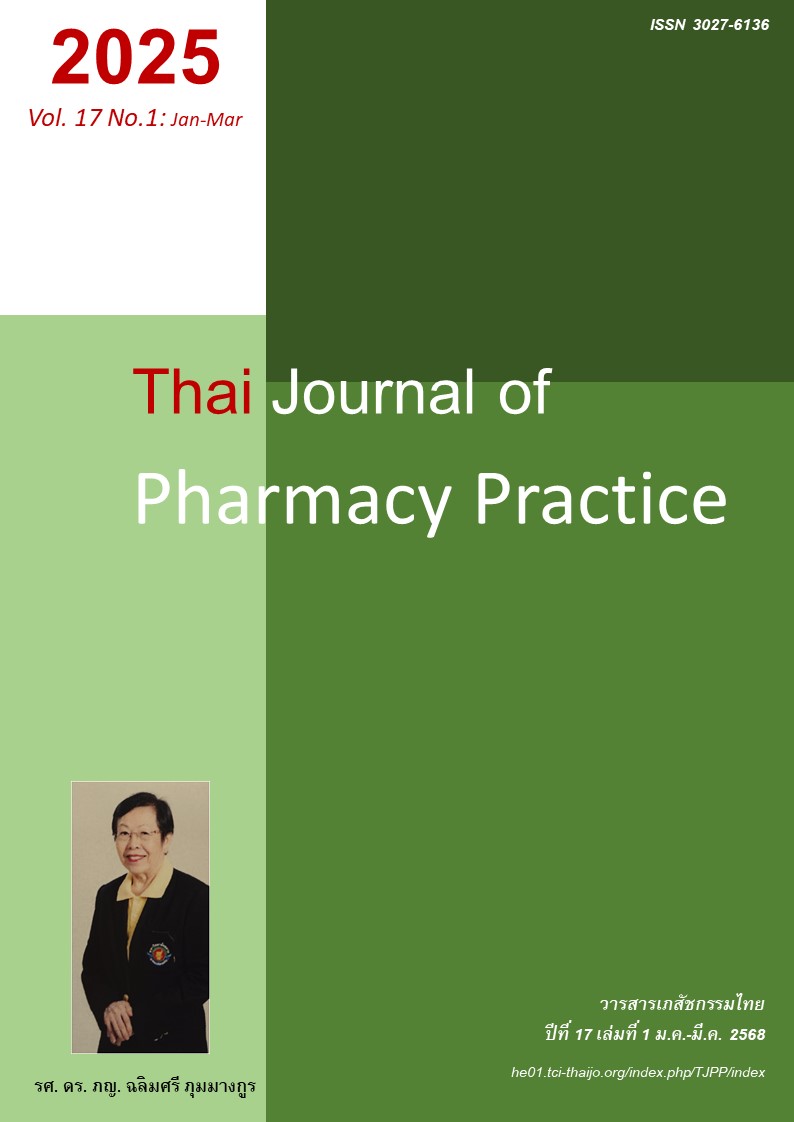ความรอบรู้สารสนเทศอิเล็กทรอนิกส์ด้านสุขภาพ ความรอบรู้ด้านสุขภาพ และพฤติกรรมการดูแลตนเองของประชาชนกลุ่มเสี่ยงโรคเบาหวานและโรคความดันโลหิตสูงในอำเภอกันตัง จังหวัดตรัง
Main Article Content
บทคัดย่อ
วัตถุประสงค์: 1) เพื่อศึกษาความรอบรู้สารสนเทศอิเล็กทรอนิกส์ด้านสุขภาพ (electronic-health literacy: e-HL) ความรอบรู้ด้านสุขภาพ (health literacy: HL) และพฤติกรรมการดูแลตนเองของประชาชนกลุ่มเสี่ยงโรคเบาหวานและโรคความดันโลหิตสูงในอำเภอกันตัง จังหวัดตรัง และ 2) เพื่อทำนายพฤติกรรมการดูแลตนเองฯ ด้วย e-HL และ HL วิธีการ: การศึกษานี้เป็นการวิจัยแบบภาคตัดขวาง กลุ่มตัวอย่าง คือ ประชาชนกลุ่มเสี่ยงโรคเบาหวานและโรคความดันโลหิตสูงในพื้นที่รับผิดชอบของโรงพยาบาลส่งเสริมสุขภาพตำบลในอำเภอกันตัง จังหวัดตรัง จำนวน 374 คน ที่เลือกมาด้วยวิธีการสุ่มแบบชั้นภูมิตามสัดส่วนของประชากรในแต่ละตำบล การเก็บข้อมูลดำเนินการในช่วงเดือนพฤศจิกายน 2567 โดยใช้แบบสอบถามชนิดตอบเองเพื่อประเมิน e-HL, HL และพฤติกรรมการดูแลตนเองฯ ผลการศึกษา: ตัวอย่างมีคะแนนเฉลี่ย e-HL, HL และพฤติกรรมการดูแลตนเองฯ เท่ากับ 3.36 ±1.05, 3.81 ±0.77 และ 3.63 ±0.70 ตามลำดับ (จากคะแนนเต็ม 5) HL ด้านการเข้าใจข้อมูลในการดูแลตนเอง (Beta=0.30, P<0.001) และ HL ด้านการตัดสินในการจัดการตนเอง (Beta=0.19, P=0.003) สามารถอธิบายความแปรปรวนของพฤติกรรมการดูแลตนเองฯ ได้ ร้อยละ 20.30 สรุป: ผู้เกี่ยวข้องควรให้ความสำคัญกับการพัฒนา HL ของประชาชน โดยเฉพาะอย่างยิ่งในด้านการเข้าใจข้อมูลการดูแลตนเอง และด้านการตัดสินใจในการจัดการตนเอง เพื่อให้ประชาชนกลุ่มเสี่ยงมีพฤติกรรมการดูแลตนเองที่ดีต่อไป
Article Details

อนุญาตภายใต้เงื่อนไข Creative Commons Attribution-NonCommercial-NoDerivatives 4.0 International License.
ผลการวิจัยและความคิดเห็นที่ปรากฏในบทความถือเป็นความคิดเห็นและอยู่ในความรับผิดชอบของผู้นิพนธ์ มิใช่ความเห็นหรือความรับผิดชอบของกองบรรณาธิการ หรือคณะเภสัชศาสตร์ มหาวิทยาลัยสงขลานครินทร์ ทั้งนี้ไม่รวมความผิดพลาดอันเกิดจากการพิมพ์ บทความที่ได้รับการเผยแพร่โดยวารสารเภสัชกรรมไทยถือเป็นสิทธิ์ของวารสารฯ
เอกสารอ้างอิง
Public Health System Development Unit. NCD clinic plus quality assessment operation manual. Nontha- buri: Bureau of Non-Communicable Disease, Depart ment of Disease Control, Ministry of Public Health; 2017.
National Health Security Office. National Health Security Fund Management Manual: Management of chronic disease prevention and control budget group (diabetes and hypertension prevention and control services). Bangkok: Thana Press; 2021.
Bureau of Non-Communicable Disease, Department of Disease Control. NCD clinic plus quality assess- ment operation manual. Nonthaburi: Aksorn Graphic and Design; 2018.
Ministry of Public Health. HDC database [online]. 2021 [cited Nov 1, 2024]. Available from: lri.hdc. moph.go.th
National Statistical Office. The survey on information and communication technology usage in households [online]. 2018 [cited Nov 1, 2024]. Available from: www.nso.go.th/sites/2014/DocLib13/ICT/household-technology/2561/ict61-CompleteReport-Q1.pdf
Department of Health Service Support, Health Education Division, Ministry of Public Health. Health education program for health literacy enhancement in new diabetic-hypertensive patients. Bangkok: 25 Media; 2020.
Chamnansua P, Kheokao J, Chumchai P, Duangkam T, Jaruphisitphaibun C, Hongthong K, et al. Health information literacy, eHealth literacy, and Health status of nursing students in Nursing colleges under Jurisdiction of the Praboromarajchanok Institute (PBRI), in the Central Region 2 Network and North-eastern Region Network. Thai Library Association Research Journal 2016; 9: 93-117.
Duangchan C, Kheokao J, Chamnansua P, Meebunmak Y, Howharn C, Chumchai P, et al. Factors predicting ehealth literacy of nursing students in nursing colleges under jurisdiction of Praboromarajchanok Institute. EAU Heritage Journal. 2017; 11: 235-48.
Rattanawarang W. Elderly’s internet usage for health information in Bangkok region. Journal of Behavioral Science for Development. 2015; 7: 169-85.
Nutbeam D. Health literacy as a public health goal: a challenge for contemporary health education and communication strategies into the 21st century. Health Promot Int. 2000; 15: 259-67.
Sørensen K, Van den Broucke S, Fullam J, et al. Health literacy and public health: a systematic review and integration of definitions and models. BMC Public Health. 2012; 12: 80.
Norman CD, Skinner HA. eHealth literacy: Essential skills for consumer health in a networked world. J Med Internet Res. 2006; 8: e9.
Schiavo R. Health communication: From theory to practice. 2nd ed. San Francisco: Jossey-Bass; 2014.
World Health Organization. Global report on diabetes. Geneva: World Health Organization; 2016.
World Health Organization. Hypertension [online]. 2021 [cited Nov 1, 2024]. Available from: www.who. int /news-room/fact-sheets/detail/hypertension.
National Statistical Office. Survey on the use of information and communication technology in households, 2018 [online]. 2018 [cited Nov 1, 2024]. Available from: www.nso.go.th/
Ruangrattanatrai W, et al. Health literacy model regarding electronic health information to enhance self-management of people at risk for diabetes and hypertension in Thailand. Nonthaburi: Strategy and Planning Division, Ministry of Public Health; 2024.
Nutbeam D. The evolving concept of health literacy. Soc Sci Med. 2008; 67: 2072-8.
Paasche-Orlow MK, Wolf MS. The causal pathways linking health literacy to health outcomes. Am J Health Behav. 2007; 31(Suppl 1): S19-26.
Seesun C, Panyasaisophon T. The effectiveness of health literacy program in type II diabetes patients at Pak Thong Chai Hospital. Medical Journal of Srisaket Surin Buriram Hospitals 2021; 36: 519-32.
Tongkhum R. Effects of health literacy promotion on the self-care behaviors of patients with type II diabetes mellitus in Lopburi province. Singburi Hospital Journal 2022; 30: 45-52.
Hemmara E, Muanpawong T. The development of health behavior tracking model on chronic disease risk groups in the new normal of life under the COVID-19 situation, Khuan Don District, Satun Province. Journal of Public Health Innovation 2022; 2: 50-66.


